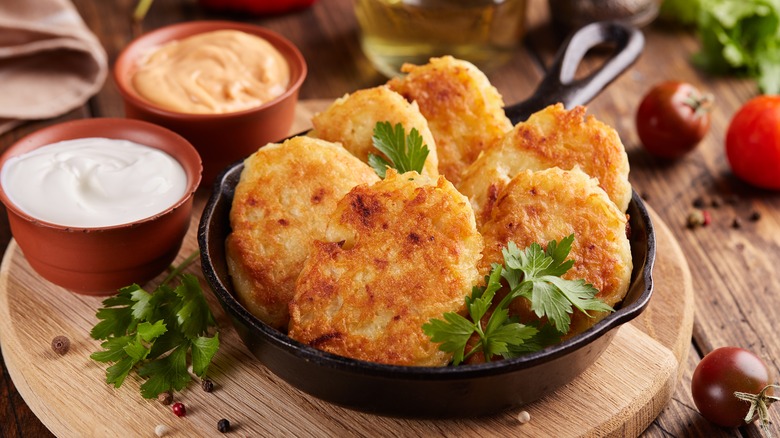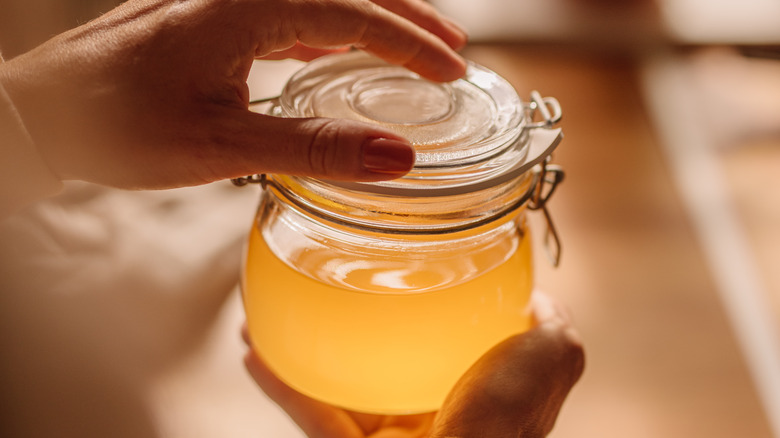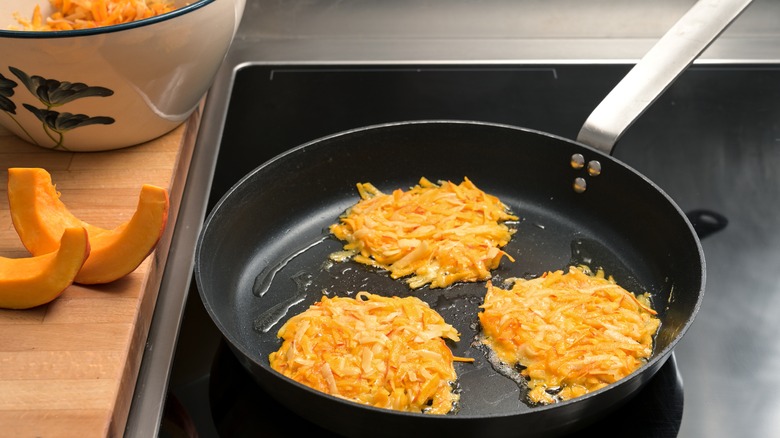Why It's A Mistake To Cook Hash Browns In Butter
Crunchy golden hash browns are often one of the best bits of breakfast and brunch. The comforting carby treat takes its name from the French verb hacher, meaning to chop up, and the best hash browns do so well, when they are all about the combination of textures and bite. To get the best results for your mouth, the sizzling potatoes should be gorgeously crispy outside, and fluffy and tender inside. To do so, the right kind of cooking fat is key.
While oil is often used for its high smoke point and neutral flavor, allowing the potatoes to take center stage, sometimes it's tempting to add a richer flavor. Butter is, of course, the first thought. But, frying hash browns in regular butter is one of the mistakes everyone makes, as its low smoke point means that the exterior can burn too quickly while the center is still not cooked enough.
If you want to get the rich buttery flavor but without the risk of burning, then you can still use the spread; you just need to get rid of the milk solids and water first. Clarified butter, also known as ghee, can do the trick to deliver all the taste, but can be used for cooking at higher temperatures.
For rich golden hash browns, try clarified butter
The reason clarified butter works so much better than an ordinary stick of butter for hash browns has everything to do with the temperature it can be heated to before starting to burn. Butter has a low smoke point of just 350 degrees Fahrenheit, whereas clarified butter can be cooked up to a much higher heat of 485 degrees Fahrenheit.
Clarified butter might seem like an unnecessary extra step for cooking hash browns, but it's quick to do, and it's well worth spending the extra few minutes to get a crispier result. To make liquid gold (clarified butter, or ghee), simply heat unsalted butter in a pan until it melts and begins to separate into layers. Then spoon off the watery foam and pour the rich yellow liquid into a jar through a strainer, so that the milk proteins are left behind and can be disposed of. Unsalted butter is best for making clarified butter; you can always season the hash browns separately for a saltier flavor.
Alternatively, you could try a mixture of oil and butter to cook hash browns. Adding in some vegetable oil means the butter won't burn so readily, but you still get the desirable taste of butter. Try a ratio of 4 tablespoons of butter to 1 tablespoon of oil for a rich result that crisps well without browning too fast.
More ways to take crispy hash browns to the next level
Clarified butter is not the only fat to try for hash browns that will have heaps of flavor. Bacon fat or duck fat can add rich, savory smokiness. If you're worried about the flavor being overpowering, you could always use half the animal fat and half oil or butter to get a similar rich taste but in a slightly less powerful dose.
As for how to serve crispy hash browns, they make a great breakfast accompaniment, of course. But there are so many more ways to enjoy the crispy potatoes. Try baking the hash brown mix on a greased sheet in the oven for a pizza-style base, which you can top with eggs, cheese, bacon, mushrooms, or whatever else you fancy for a brunch dish with a twist. Or go even further into pizza territory by topping the crisply cooked hash brown base with pizza sauce and a meaty or vegetable-based topping, and baking again with cheese until melted.
Alternatively, try using two crispy hash browns fried in clarified butter to replace the usual bread bun for a breakfast sandwich or burger. Or go for totally different taste sensation altogether by switching half the grated potato for grated squash, celeriac, or parsnip for a rich root vegetable flavor. However you serve them, just make sure they're at their crispy best by avoiding the butter — unless it's clarified.



